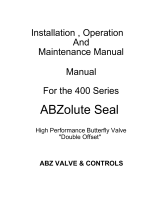
2
3. For automated valves, set the air pressure/
electrical voltage for at least the minimum
given to operate the actuator. For pneumatic
actuators, do not apply more than 1.25times
the pressure for which the actuator was
designed.
WARNING
When placing the valve into the bench vise, make
sure the small end of the disc (2) taper pin faces
the assembler. (see Figure 1)
Hold the punch with a punch holder or a pair of
vise grips. Otherwise, serious injury may occur.
Removing the disc-to-shaft tapered pin
connections
1. Open the valve disc (2) to its full open
position.
Note: on valve sizes NPS 10 (DN 250) and
larger, it is recommended that two workers
perform the disc tapered pin (5) removal
process.
2. Place the disc in a vise.
3. Using a tool steel punch, locate the punch
on the small end of the disc taper pin (5) and
then strike the punch with a heavy hammer.
DISASSEMBLY
To begin disassembly, refer to the parts list
(Figure 4) and proceed as follows:
WARNING
Depressurize the valve and associated piping
before disassembly. Failure to do so may cause
serious personal injury and/or equipment
damage.
1. Remove the valve from the line. Clean
the valve according to proper cleaning
procedures as outlined by the plant or
according to a prescribed procedure.
2. Remove the actuator and relevant
connecting key. Note the actuator position
relative to the valve.
3. Removing the Bracket and Adapter
To disassemble adapter and bracket
remove the following components
: Bracket (30)
: Adapter (28)
: Washers (31, 33)
: Bolts (32)
: Grub screw (34)
. : Key (27)
: Nuts (16)
CAUTION
Throughout disassembly and assembly, always
use cardboard or brass shims to protect the
valve body, disc, flange and sealing surfaces from
damage. Failure to do so may result in serious
damage to the valve.
OPERATION
The K-LOK has been designed to require a
minimum of maintenance. Generally, only
maintenance on the packing box is required.
MAINTENANCE
If shaft leakage is observed through the packing
box, tighten the gland nuts.
Note: do not over-tighten packing box gland
nuts. Over-tightening will increase the torque
required to operate the valve. When tightening
the gland nuts, use half-turn increments until
leakage has stopped.
VALVE CHECKOUT
1. Tighten the packing gland bolting just
enough to prevent shaft leakage. Over-
tightening will decrease packing life and
increase operating torque requirements.
2. Check the operation of the valve by stroking
it to ‘full open’ and ‘full close’. To determine
the valve orientation of the disc, double
D’s and keyways are aligned with the disc.
The valve disc travels clockwise to close.
INSTALLATION
The valves are shipped with flange gasket
surface protection. Before installing the valve,
remove the protection and carefully clean and
de-grease both surfaces with a solvent.
Series 36 and 37 – Wafer style
1. Orient the valve with the directional flow
arrow (preferred direction) pointing in the
proper direction.
2. Insert the valve between the flanges until
the alignment holes at either side of the
valve match the corresponding holes in
the flanges.
3. Insert a long bolt or stud through the flange
and thread it through the alignment hole.
This will allow the valve to center itself
properly for the installation of the flange
gaskets.
4. Install the flange gaskets and the remaining
flange bolting.
5. Remove the long bolts/studs from the lower
alignment holes and replace with correctly-
sized bolts.
6. Using the crossover method, tighten all
flange bolts.
KEYSTONE K-LOK
®
SERIES 36 AND 37 HIGH PERFORMANCE BUTTERFLY VALVE
ISO VERSION INSTALLATION AND OPERATION MANUAL
Figure 1 - Valve properly clamped in place.
Note: for spring return actuators with
positioners, overpressure will cause excessive
time delay in the spring movement for the valve
disc to travel out of the seat.
Note: Some of the weld on the taper pins (5)
may need to be removed by grinding.









